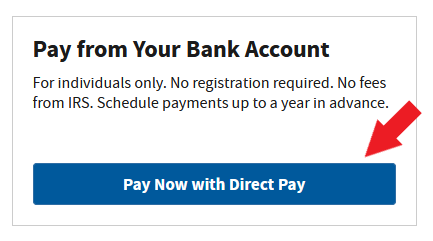Written by Eamonn McElroy, CPA, Atlanta
Originally published September 25, 2021; Last updated May 18, 2022
Background
Many individual taxpayers are required to make quarterly estimates of their tax liability to avoid underpayment penalties. Traditionally, these payments are made by mailing a check or money order with a voucher. However, for those taxpayers who don’t mind paying their quarterly estimates online, IRS Direct Pay is more convenient and faster than the traditional method. IRS Direct Pay allows an individual taxpayer to use their checking account to schedule a quarterly estimate payment up to 365 days in advance. The payment limit under IRS Direct Pay is very large – $10 million per transaction – which means that almost all individual taxpayers can utilize this platform.
How to get started and pay your 1040 quarterly estimate with IRS Direct Pay
Navigate to https://www.irs.gov/payments and click “Pay Now with Direct Pay” under “Pay from Your Bank Account”.

You have been taken to a new screen. On this new screen, click “Make a Payment”.

You have been taken to a new screen that looks like this:

Step 1 (Tax Information):
On this new screen, select:
- “Estimated Tax” under “Reason for Payment”,
- “1040ES (for 1040, 1040A, 1040EZ)” under “Apply Payment To”, and
- the relevant tax year to apply the payment to under “Tax Period for Payment”.
Important: Please take extra care to make sure that the appropriate year is chosen for fourth quarter (Q4) payments as these payments are often made in January of the following year. For example, the 2022 tax year Q4 estimate is due in January 2023. In this example one should take care to enter “2022” under “Tax Period for Payment” NOT 2023. Failure to select the correct tax year will result in an IRS matching error.
After populating the three drop down boxes and carefully reviewing, click “Continue”.
Step 2 (Verify Identity):
You will be taken a new screen. On this new screen, you will enter information from one of your most recently filed tax returns to verify your identity. For this step, you will need a copy of the applicable year’s as-filed tax return (IRS Form 1040). Proceed to fill in the required information for the tax year you have chosen.
Important: If you paper filed your most recent tax return and it has not yet been processed by the IRS, you will NOT be able to use that tax year to verify your identity. Please choose the next most recent tax year available to you that has been processed by the IRS for this verification step.
Click “Continue” after you have completed all required fields.
Step 3 (Your Payment Information):
Proceed to enter in the amount you would like to pay for this federal quarterly estimate. Do NOT include any state or local estimate amounts, only federal.
Choose the date you would like to schedule the payment to be made. Please take into consideration and double check the due date of this quarterly estimate, and schedule the payment no later than the due date.
Enter in your account information and the email address at which you’d like to receive a confirmation email.
Important: Many financial institutions will not allow a direct debit or an electronic funds transfer from a savings account and will reject the transaction. For this reason, it is generally advisable to use a checking account instead of a savings account.
Click “Continue” after you have reviewed your entries.
Step 4 (Review & Sign):
Carefully review all information on this page. Edit if necessary. Otherwise, enter the requested information to electronically sign for the payment submission and click “Submit”.
Step 5 (Confirmation):
Print this confirmation page (or save as a PDF) and retain in your tax records. If a tax professional or third party prepares your tax returns, give them this confirmation page along with your other source documents.
Click “Sign Out” at the top of the screen near your name. Close the browser tab. You’re done!
Copyright © Eamonn McElroy CPA, LLC.
Disclaimer: Tax law, regulation and procedure are constantly changing. Eamonn McElroy CPA, LLC has provided this article as general information only and is under no obligation to update the article for future changes, including but not limited to changes in tax law or procedure. The information contained in the article is not tax, investment or legal advice, nor should it be construed as tax, investment or legal advice. You should consult with your advisors to determine how the information in this article affects you and what actions you may take and should take.
